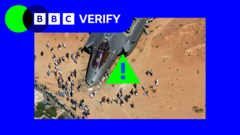As artillery strikes resume across the disputed region of Kashmir, both nations navigate the complexities of military strikes amidst misinformation and increasing global scrutiny.
**India-Pakistan Conflict Escalates: A Looming Humanitarian Crisis**

**India-Pakistan Conflict Escalates: A Looming Humanitarian Crisis**
The decade-long tensions between India and Pakistan over Kashmir have intensified, causing civilian casualties and emergency responses.
On the evening of May 9, 2025, reports indicate that India and Pakistan are embroiled in an unprecedented scale of military conflict, reminiscent of the fierce battles that characterized past decades. This escalation comes following an Indian airstrike on Pakistani targets earlier in the week, which subsequently led to retaliatory attacks from Pakistan, marking a new chapter in the long-standing territorial disputes over Kashmir.
The situation on the ground is dire. In India-administered Kashmir, reports reveal that villages like Poonch have faced heavy shelling, leading to evacuations and community distress. Local sources indicate at least 13 civilian casualties, raising alarms about the potential humanitarian disaster brewing in this already volatile region. Residents are burdened with fear of frequent drone incursions, and many have opted to evacuate their homes in search of safety.
Indications suggest that both involved nations are currently engaged in utilizing advanced military capabilities; drones and tactical missiles are being employed more frequently than seen in prior conflicts. Indian military forces announced interception of Pakistani drone assaults; however, similar claims from Pakistan have countered the narrative, adding to a fog of disinformation overshadowing the truth of ongoing events.
The hostility has bulldozed past diplomatic discussions aimed at resolving the crisis peacefully. Pakistani leaders have declared that any blockade of water could be considered an act of war, heightening the stakes as tensions not only arise from military engagements but also economic and resource permeability. Schools in border regions have been ordered closed, seemingly a precursor to further military actions.
In order to understand the intensity of this conflict, it is crucial to address the underpinnings that led to the current hostilities. The latest clash was triggered by a terrorist attack that resulted in multiple civilian deaths — an unfortunate pattern that seems to rekindle each time one side holds the other accountable for acts of terrorism in the intertwined narratives of Kashmir.
With both countries relying heavily on international arms suppliers, shifts in these relationships are also critical to consider. India has notably decreased its dependence on its traditional ally, Russia, while increasing arms purchases from Western nations. In contrast, Pakistan has pivoted towards China for military supplies, indicating a complex geopolitical shift in which superpowers influence local stability.
As fears continue to mount among civilians and governments, the international community remains vigilant for signs that could prevent a broader conflagration. However, the legacy of violence and suspicion complicates any pathway to peace. The coming days will serve as a pivotal juncture that may determine the fate of realm, as domestic leaders on both sides grapple with national pride against the backdrop of embattled civilian populations.
The situation on the ground is dire. In India-administered Kashmir, reports reveal that villages like Poonch have faced heavy shelling, leading to evacuations and community distress. Local sources indicate at least 13 civilian casualties, raising alarms about the potential humanitarian disaster brewing in this already volatile region. Residents are burdened with fear of frequent drone incursions, and many have opted to evacuate their homes in search of safety.
Indications suggest that both involved nations are currently engaged in utilizing advanced military capabilities; drones and tactical missiles are being employed more frequently than seen in prior conflicts. Indian military forces announced interception of Pakistani drone assaults; however, similar claims from Pakistan have countered the narrative, adding to a fog of disinformation overshadowing the truth of ongoing events.
The hostility has bulldozed past diplomatic discussions aimed at resolving the crisis peacefully. Pakistani leaders have declared that any blockade of water could be considered an act of war, heightening the stakes as tensions not only arise from military engagements but also economic and resource permeability. Schools in border regions have been ordered closed, seemingly a precursor to further military actions.
In order to understand the intensity of this conflict, it is crucial to address the underpinnings that led to the current hostilities. The latest clash was triggered by a terrorist attack that resulted in multiple civilian deaths — an unfortunate pattern that seems to rekindle each time one side holds the other accountable for acts of terrorism in the intertwined narratives of Kashmir.
With both countries relying heavily on international arms suppliers, shifts in these relationships are also critical to consider. India has notably decreased its dependence on its traditional ally, Russia, while increasing arms purchases from Western nations. In contrast, Pakistan has pivoted towards China for military supplies, indicating a complex geopolitical shift in which superpowers influence local stability.
As fears continue to mount among civilians and governments, the international community remains vigilant for signs that could prevent a broader conflagration. However, the legacy of violence and suspicion complicates any pathway to peace. The coming days will serve as a pivotal juncture that may determine the fate of realm, as domestic leaders on both sides grapple with national pride against the backdrop of embattled civilian populations.























